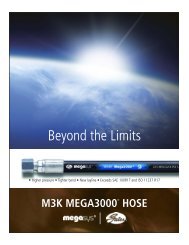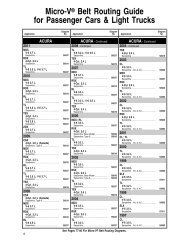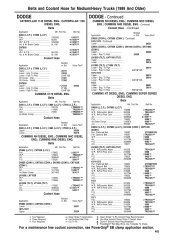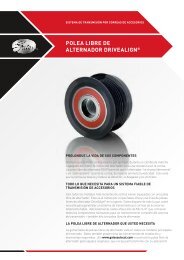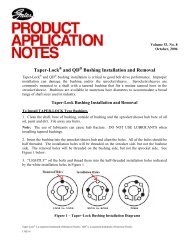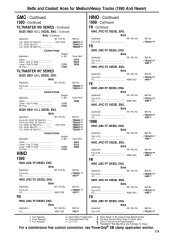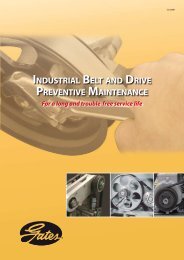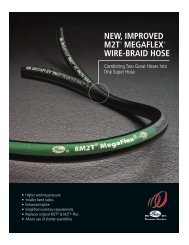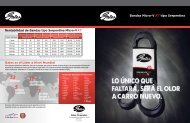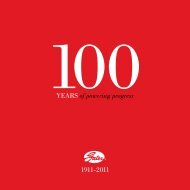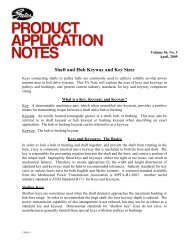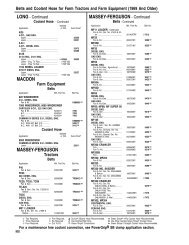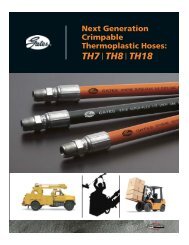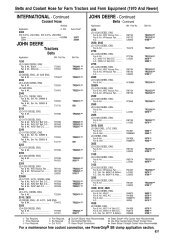PowerGrip® GT® Belt Drives
PowerGrip® GT® Belt Drives
PowerGrip® GT® Belt Drives
You also want an ePaper? Increase the reach of your titles
YUMPU automatically turns print PDFs into web optimized ePapers that Google loves.
Polyflex ® JB ® and Micro-V ® <strong>Belt</strong>s – Engineering<br />
VI. Idler Usage<br />
– continued<br />
Figure 28 – Equal Arcs<br />
A flat idler pulley (inside or backside) should be<br />
positioned in the span so that the distance between<br />
the idler and the sheave following the idler (in the<br />
direction the belt is traveling) is reasonably large.<br />
See Fig. 29 below. In this position, possible<br />
misalignment due to belt tracking will be minimized<br />
because the increased span length allows the belt to<br />
“realign” itself before entering the adjacent sheave.<br />
This, however, reduces the amount of idler<br />
movement available for belt takeup.<br />
Figure 29 – Locating Flat Idler<br />
In certain applications that have long belt spans and<br />
moderate shock loading, span vibration or belt whip<br />
may occur. If this happens, span vibration can be<br />
minimized by breaking up the long belt spans with<br />
contact idlers.<br />
Tight or slack spans<br />
Figs. 30 and 31 show the idler positioned on the<br />
tightside and slackside spans of the drive.<br />
Figure 30 – Tightside Idler<br />
Figure 31 – Slackside Idler<br />
If possible, the idler should be placed on the<br />
slackside span of the drive (See Fig. 31) rather than<br />
on the tightside.<br />
The span tension directly influences the amount of<br />
stress on the belt. Since the operating tensions are<br />
lower in the slackside span, the belt stresses are<br />
significantly reduced when the idler is placed in this<br />
span. By lower belt stresses, the amount of fatigue<br />
is reduced which results in longer belt life.<br />
Spring-loaded idlers provide belt tension<br />
proportional to the load being transmitted. A useful<br />
paper, “Spring-Loaded Idler Designs for V-<strong>Belt</strong><br />
<strong>Drives</strong>” ASAE Paper No. 75-1524 is available from<br />
Gates Application Engineering upon request.<br />
This text describes proper design and analysis<br />
procedures, as well as a comparison between the<br />
operating characteristics of spring-loaded<br />
(automatic) and manual tensioning systems.<br />
Spring-loaded or weighted idlers should always be<br />
located on the slackside because the spring force,<br />
or weight, can be much less in this position. In<br />
addition, these idlers should not be used on a drive<br />
where the load can be reversed; i.e., where the<br />
slackside can become the tightside.<br />
Contact Gates Application Engineering for<br />
assistance in determining the force which idlers<br />
must impose on belts. The idler force must be such<br />
that the resulting belt tension in the span over the<br />
idler is equal to the slack span operating tension.<br />
Calculate the span operating tensions using the<br />
procedure outlined in Section X. <strong>Belt</strong> Pull and<br />
Bearing Loads on Page 85.<br />
B. Idler Diameters<br />
Idler diameters should be at least as large as the<br />
recommended sheave diameters in Table 42.<br />
Table 42 – Minimum Recommended<br />
Idler Diameters<br />
Min. O.D. of Min. O.D. Min. O.D. of<br />
<strong>Belt</strong> of Grooved of Flat Inside outside or Backside<br />
Cross Section Idler (in) Idler (in) Idler (in)<br />
J Micro-V 0.80 0.65 1.25<br />
5M Polyflex JB 1.04 0.90 2.90<br />
C. Grooved or Flat<br />
Inside idlers may be either grooved or flat, and<br />
backside idlers should always be flat.<br />
It is important to remember an outside idler on the<br />
ribbed back of Polyflex JB belts may be noisy. For<br />
additional information, refer to Section I, Part C on<br />
Page 76.<br />
D. Idler Details<br />
Flat idlers should not be crowned. However,<br />
flanging of idlers is good practice. If flanges are<br />
used, the inside bottom corner should not be<br />
rounded because this may cause the belts to climb<br />
off the pulleys.<br />
Brackets for idlers should be rigid. Drive problems<br />
described as “belt stretch,” “belt instability,” “short<br />
belt life,” “belt vibration” and others are frequently<br />
traced to flimsy idler bracketry. This bracketry must<br />
be designed to withstand the forces imposed by the<br />
operating belt tensions.<br />
The World’s Most Trusted Name in <strong>Belt</strong>s, Hose & Hydraulics.<br />
81



